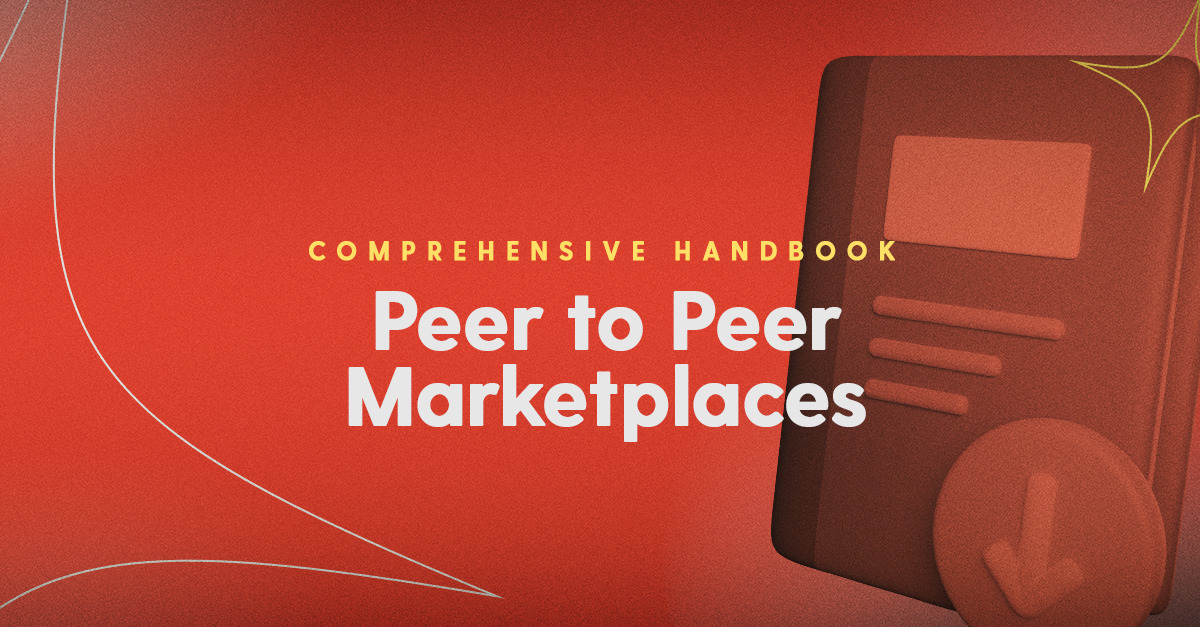Peer to peer marketplaces like Airbnb, Etsy and Fiverr are surging in popularity — offering a scalable, low-overhead way to build your own online marketplace platform.
Whether you’re looking to develop the next billion dollar company or just looking for a way to build a marketplace that you can generate some side income from & potentially sell quickly on a website like Acquire.com for a few hundred thousands dollars, this article is for you.
In this 2025 guide, you’ll learn how to build a peer to peer marketplace platform from idea to launch. We’ll break down the best business models, examples of P2P marketplaces, how to validate your niche, and the tech stack you’ll need — all in under 10 hours using hybrid no-code marketplace software.
We are going to cover all of the fundamental concepts on how to build, launch & grow a successful peer to peer marketplace. We will look at:
- What are peer to peer marketplaces?
- Types of peer to peer marketplace
- Pros and challenges of building a peer to peer marketplace
- Essential features of a peer to peer marketplace
- How to build & launch a peer to peer marketplace in under 10 hours
- Peer to peer marketplace examples
- Final thoughts: What’s next?
What Is a Peer to Peer Marketplace Platform?
A peer to peer (P2P) marketplace, also called a multi-vendor or online marketplace is a website or app that acts like a middleman to help buyers and sellers easily find each other.
It’s like having a big bulletin board where sellers can list products and services to either buy or rent. Buyers can then connect with sellers to buy or rent out what is on offer.
Perhaps the best known peer to peer marketplace platform is Airbnb. Airbnb is a peer to peer, location based, rental marketplace. This means that buyers visiting the Airbnb website can see a list of properties to rent. The properties displayed are near to the location they are visiting. Buyers can click on individual properties, read details about the properties and connect with the property managers to rent the properties via the Airbnb platform.
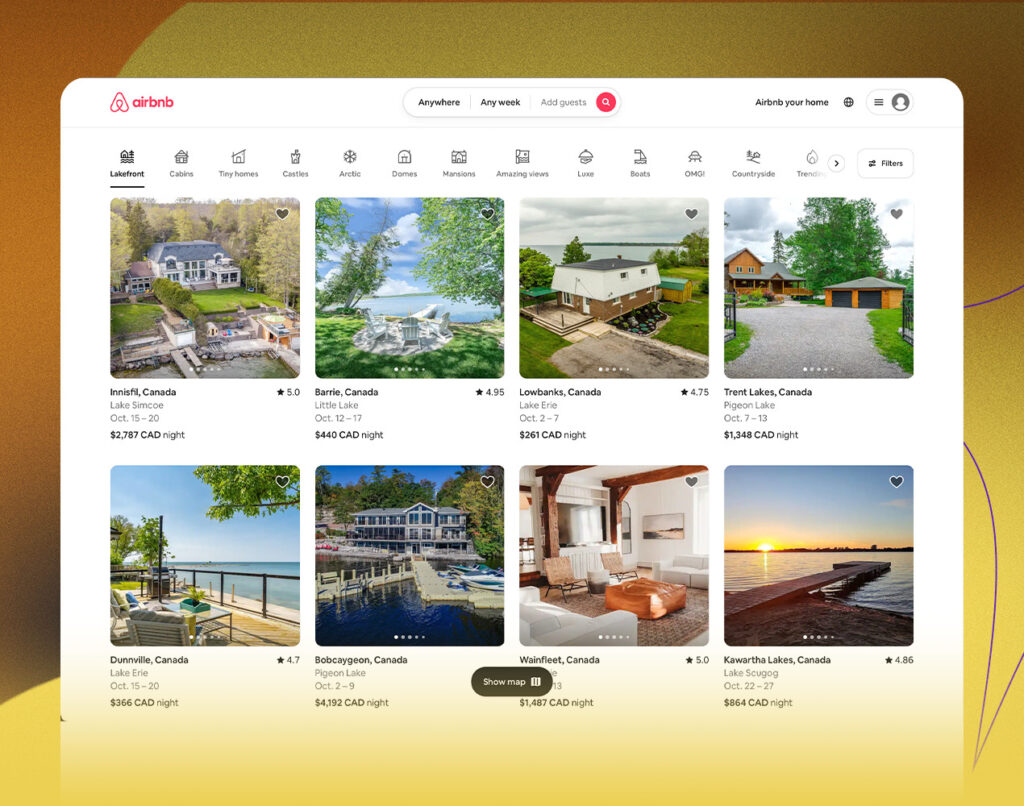
Types of Peer to Peer Marketplaces (Product, Service, Rental)
There are three main types of peer to peer marketplace:
Peer to Peer Product Marketplaces
Peer to peer product marketplaces are platforms that facilitate the buying and selling of physical or digital goods.
One example of a very successful product marketplace is Etsy which is a platform for sellers to list unique, handmade goods. Another example of a product marketplace is Chewy (see below). Chewy is US based, niche p2p marketplace business model, designed for pet owners looking for affordable pet food, treats, pet health care, and other supplies.
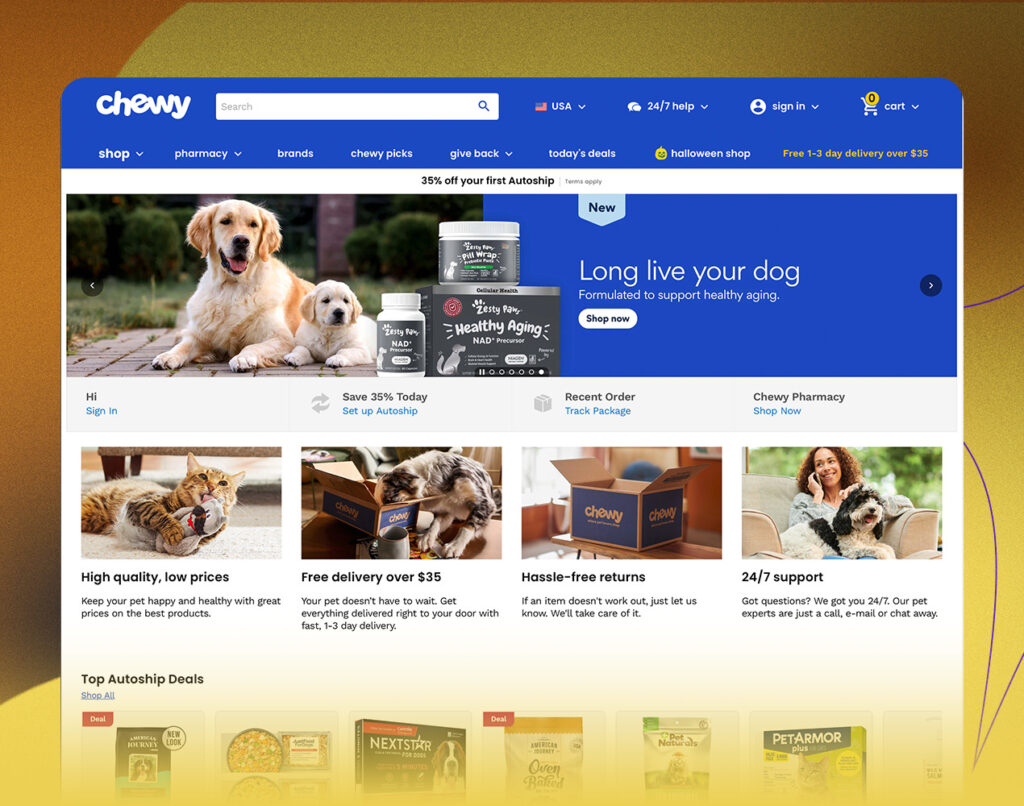
Nowadays entrepreneurs can easily craft unique & niche product peer to peer ecommerce by using solutions like Dittofi (online marketplace builder).
Niche marketplaces offer a number of deep-rooted, long-term advantages. Like many successful products, niche solutions emerged in response to a common pain point. For instance, how about a product marketplace platform for expat communities looking for products from their home country? An artisanal food marketplace that connects small scale food producers with consumers who value high quality handmade food products? A marketplace for handmade toys & crafts? The list of possibilities is literally endless.
You may even think of a time when you’ve Googled for a product to buy & failed to find it easily available online. If you are searching for it, the chances are that someone else is also searching for it.
Check out Dittofi’s peer to peer product marketplace templates. Learn how you can customize this for your needs.
Peer to Peer Service Marketplaces
Service-oriented P2P marketplace platforms connect people who need specific services with individuals or businesses offering those services. Some of the most famous examples of these marketplaces include apps like Uber (for taxis), Upwork (for freelancers), Thumbtack (for local services), & TaskRabbit (for various tasks and errands).
There are limitless possibilities to carve out a niche for yourself. How about matching local guides with tourists? Or what about building a marketplace of IT professionals wanting to offer remote tech support? Or helping people find local event planners for professional functions?
Whilst all service based marketplaces are unique, there are a set of features that are common to all of them. You can jumpstart your service based marketplace with Dittofi’s peer to peer service marketplace template (see below).

Peer to Peer Rental Marketplaces
These platforms allow people to rent items or equipment from others, such as tools, equipment, or even clothing. Examples include Airbnb (for short-term accommodations) & Turo (for car rentals).
When people think about rental marketplaces they normally just think about short term vacation rentals like Airbnb. However, you can rent out just about anything & as with product & service based marketplaces, there is a lot of opportunity to build niche marketplaces for different types of products.
How about a marketplace for outdoor camping rentals targeted at tourists who are unable to bring equipment with them? A marketplace for suit, dress or jewellery rentals for high end functions? Art & decor rentals for event planners or content creators? Again, the opportunities here are endless, you simply need to find a target audience & need that they have.
Check out some examples of Dittofi’s rental marketplace templates & learn how to customize these using visual programming for your target audience & their pain point.
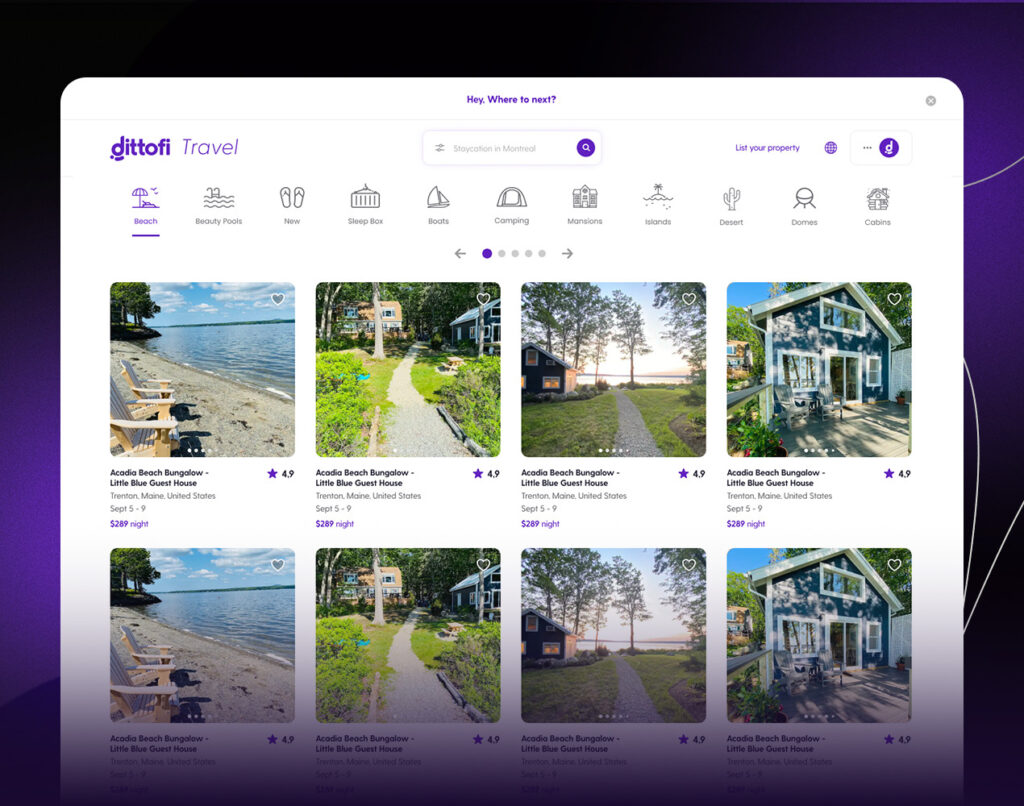
Pros and Cons of Building a P2P Marketplace
In this section we examine some of the pros & challenges of building a peer to peer marketplace platform.
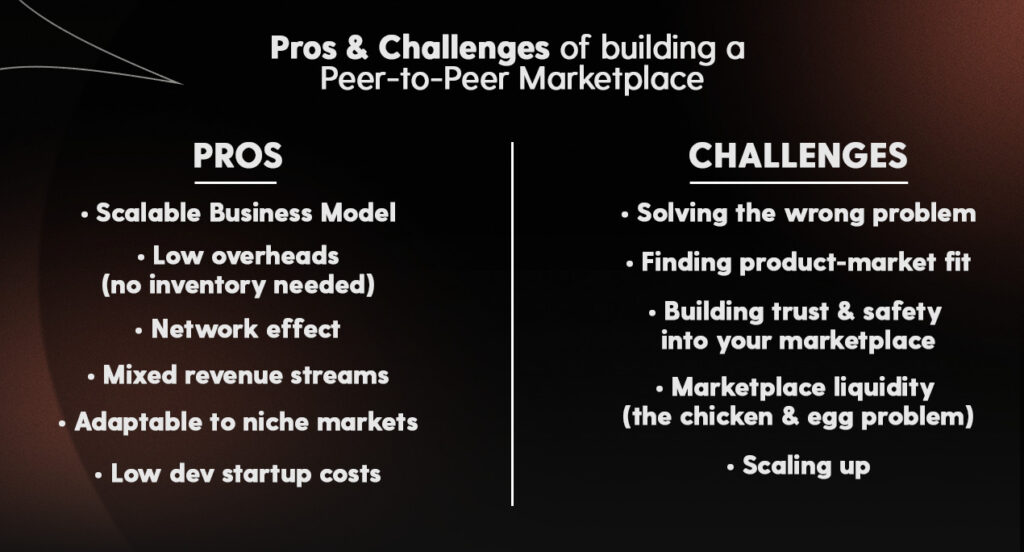
Pros of building a Peer to Peer Marketplace
There are several benefits to building a peer to peer marketplace. In this section we will break down these benefits.
Scalable business model
Peer to peer marketplaces have highly scalable p2p marketplace business model. For example, the marketplace Etsy generated $2.671 billion in revenue in 2023, Airbnb generated $9.088 billion & Uber generated a whopping $35.003 billion.
Other smaller & more niche p2p website also performed well. For example, Depop which specializes as a marketplace for vintage clothing and accessories made $85 million in 2023.
But how do you scale a marketplace platform with $0 in revenue to thousands, millions or even billions of dollars in annual revenue?
Well, there are many factors that go into scaling up your marketplace, for example product development, customer acquisition, contracts etc. However, at the heart of every successful marketplace is a core & highly scalable business model. There are different marketplace business models such as the commission model, lead fee model, listing fee model, & so on.
The most common model is the commission model where the marketplace charges a small fee (or take rate) for transacting on the marketplace. For example, let’s assume you have a marketplace that allows sellers to list land that they own & buyers to rent the land out for private functions. Buyers & sellers come to the marketplace platform & connect. When a buyer rents out the land money transfers from the buyer to the seller & the platform will take a commission on the transaction. The diagram below shows this in more detail.
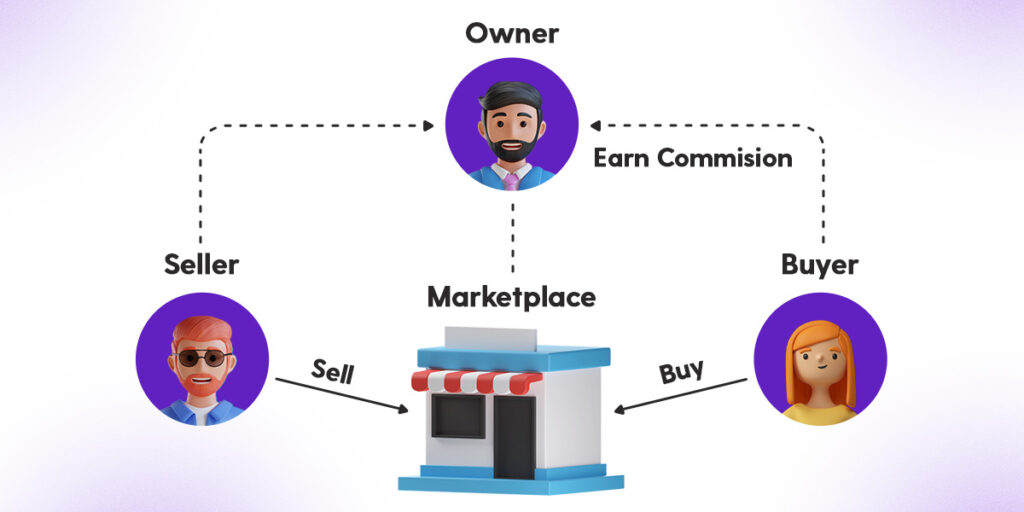
Marketplace business model is highly scalable, meaning that you can simply increase the number of transactions & the marketplace will make more money. For example, imagine you’re making $20 per transaction (as in the diagram above). If you have 1000 transactions happening per day this is $20,000 in commission revenue per day or $7.3 million per year.
The commission model is not the only business model for marketplaces. Oftentimes the commission model is combined with other models in order to generate more revenue.
There are also times when the commission model does not work for a marketplace. For example, the service based marketplace Thumbtack does not use a commission model. This is because of operational & technical challenges that they experienced when trying to build a commission model for their marketplace. Below is an interesting snippet from Sander Daniels, one of the founders of Thumbtack, who discusses how Thumbtack arrived at their marketplace business model.
Low overheads (no inventory needed)
A major advantage of peer to peer marketplaces is that they are relatively low cost to set up.
In most industries, startups will need to invest in either inventory to sell or in hiring staff that will be contracted out to buyers. By contrast, peer to peer marketplaces do not need to pay for inventory or hire staff; the suppliers do this for them.
Consider the peer to peer ridesharing marketplace, Uber. In 2022, more than 18.7 million people hailed a ride using Uber. However, Uber does not own a single car. The marketplace of drivers is entirely made up of independent contractors who are responsible for their own vehicles & expenses.
Peer to peer marketplaces focused on products & rentals work the same way. Etsy does not own any physical inventory, despite more than $13 billion in total product sales via their platform & Airbnb does not own any hotels even though an average of 2 million people per day stay in properties listed on their platform.
The only other setup costs are technology. However, platforms like Dittofi enable you to build & own highly scalable peer to peer marketplaces in a couple of clicks. This makes building a peer to peer marketplace really accessible for all entrepreneurs.
Network effect
The network effect, in simple terms, is when the value of something increases as more people use it.
Peer-to-peer marketplaces have built in network effects. For example, imagine a peer-to-peer marketplace is like a neighborhood garage sale. When more neighbors participate by selling their items, the sale becomes more attractive for shoppers. As more people bring their goods, the variety and choices grow, drawing in more shoppers. This creates a flywheel effect: more sellers attract more buyers, and more buyers attract more sellers.

The network effect is one way that your business can build a competitive advantage. For founders, going after “network effects” is a good idea because network effects are some of the cheapest & easiest ways to build a competitive advantage.
Mixed revenue models
As we have seen, peer to peer marketplaces can enjoy built-in network effects. These network effects help to accelerate growth with every new user.
As communities of people come together within the marketplace, this becomes an opportunity for the marketplace to offer more value to its users & drive more revenue for the marketplace through mixed revenue models. Consider the online marketplace Etsy.
Etsy is a marketplace where artisans, crafters, and vintage sellers can list and sell their unique handmade and vintage goods to a global audience. The business started out using only the commission model to make money. Nowadays, Etsy combines three revenue models together in order to better serve their customers & drive more revenue for their platform. These models include:
- Commission is charged as a percentage of each transaction between the buyer & seller. Etsy charges 6.5% of the total order amount in the listing currency.
- A listing fee of $0.02 is charged to the seller for each product that the seller lists on the marketplace. This fee reduces the total amount of listings, but it also helps maintain the quality of the listings added to the marketplace.
- A subscription fee is charged for add-on premium seller service that Etsy offers to its power sellers. These include tools to help with fulfilment efficiency, to manage marketing & so on.
Adaptable to niche markets
A niche p2p marketplace is one where that connects specialized vendors with their ideal customer.
Marketplaces like Amazon are often so big that it can be difficult for users to find specialized goods & services. The same goes for brands who struggle to reach their customers. If you can find a niche that is unexplored, your marketplace can be massively successful & the beauty of p2p marketplaces is that the core technology requirements & business strategies & models for all p2p marketplaces are largely the same. Therefore, there are a lot of resources out there for you to quickly set up & start to grow a new marketplace.
Low dev startup costs
It used to be the case that building a p2p marketplace was extremely complex, expensive & time consuming. Nowadays however there are a number of visual app builders such as, Dittofi’s hybrid no-code platform, that makes building p2p marketplaces fast & easy.
Platforms like Dittofi combine visual app development together with AI & auto code generation to give you a quality technology stack for your marketplace, all without having to write a single line of code. For example, the screenshot below shows how you can customize Dittofi’s rental marketplace template from inside Dittofi’s visual development studio.
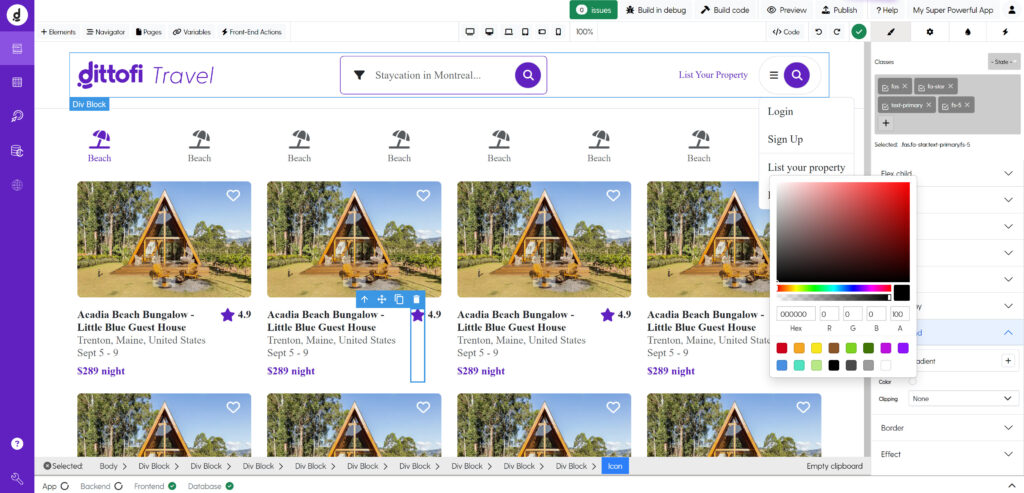
Once your marketplace has been built using Dittofi’s visual builder, Dittofi translates visual designs into a fast, secure & modern code (React & Google Go). Users can then further access, edit & deploy this code into production, all from within Dittofi’s visual app builder. Dittofi also allows users to export & own their apps technology, in case you want to take it & adapt it outside of our app builder.
Challenges of building a Peer to Peer Marketplace
There are several challenges to overcome when building a peer to peer marketplace. In this section we will break down what these challenges are & how to overcome them.
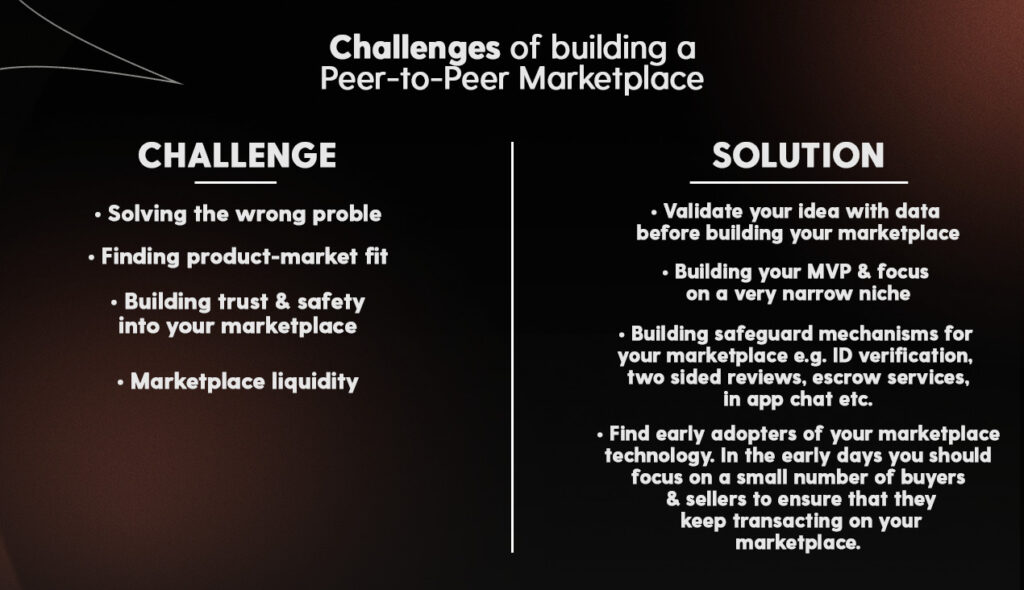
Let’s take a look at each of these challenges in more detail.
Solving the wrong problem
Before spending a significant amount of time or money in building your app, the first thing you should do is to validate your idea. In entrepreneurship, this concept is known as finding problem-solution fit. It is the process of ensuring that a product or solution effectively addresses a real & well-defined problem or need in the market.
To help validate your idea, we recommend starting with one of Dittofi’s marketplace templates and p2p marketplace examples. Write a clear & compelling value proposition for your marketplace & then go out & try & onboard real users. As you do this, collect up feedback from your users. If you cannot get anyone to sign up to your marketplace, it may be a sign that there is no real world demand for your idea. If this happens, you may need to pivot.
Finding product-market fit
Once you’ve identified that there is a real world need for your marketplace, the next step is to build out your MVP. Building your MVP is an iterative process where it is best to focus on making a small niche set of users happy. Amazon started by selling just books. Airbnb focused on offering short term rental solutions at carefully chosen, high profile, events.
While it is great to dream big, a lack of focus can slow you down. Therefore, it is best to focus on one particular niche & then scale into other markets & categories.
Building trust and safety into your marketplace
Before Amazon became a trusted online marketplace it would have seemed very risky to purchase a book from a stranger online. If you sent the payment & the book didn’t arrive in the post, I doubt many people would be that surprised. Nowadays, almost all of us will buy stuff off Amazon & we trust implicitly that whatever we purchase will arrive & if it doesn’t then Amazon will refund us.
However, a new marketplace does not have features, process, brand or reputation to make it as secure as Amazon. There are however features & processes that you can put in place to help safeguard your marketplace. For example, you might decide to build passport verification for new users, review systems, escrow services, in app chat where your operations teams can read messages sent between buyers & sellers, dispute resolution mechanisms & secure payment processing. Without these features there’s a higher chance of encountering potential scams or fraudulent buyers & sellers.
The features are only one aspect of building a trusted marketplace. Your marketplace brand & reputation need to be earned, & this takes time.
Marketplace liquidity
Liquidity is the lifeblood of peer to peer marketplaces. It is the efficiency with which a marketplace platform matches buyers and sellers on its platform. Given that a marketplace with zero liquidity has zero transactions taking place, one could say that liquidity IS the marketplace.
To achieve good marketplace liquidity, you need a balanced & active ecosystem where supply (sellers or service providers) and demand (buyers or users) align effectively. This requires strategies to attract & retain both sides of the marketplace. For the supply side, you need to onboard quality sellers, build trust, & ensure a steady stream of offerings. For the demand side, you need to focus on user acquisition & retention.
Must-Have Features in a Peer to Peer Marketplace Website
Peer to peer marketplaces require a distinct set of features compared to traditional ecommerce platforms. This means that generic store builders like Shopify, WooCommerce, BigCommerce etc. do not work well for marketplaces. Furthermore, coding a marketplace from scratch is complex, expensive & time consuming.
Well – Dittofi has a set of purpose built two-sided marketplace solutions that contain all of the essential features that you need to build & launch the first version of your marketplace. Dittofi enables you to install each of these features & then customize the underlying code for each feature using the Dittofi visual app builder. Dittofi translates all visual designs into fast, secure & modern code (React & Google Go) that you can either deploy in one click or export & own. A list of the essential features for your marketplace & how to build them are included below.
Website homepage
The homepage of your marketplace website is crucial for making a strong first impression & guiding visitors to explore further.
The homepage should include a value proposition that clearly communicates what your marketplace offers & why visitors should use it. It should also include a search bar, featured listings, listing categories, trust signals e.g. ratings & a clear call to action. The image below shows a breakdown for a website homepage of a peer to peer products based marketplace. This template is available inside of Dittofi.

User onboarding and sign up forms
Now that you have a website for your marketplace, the next step is to start onboarding new users. To do this, you will need to design buyer & seller sign up & onboarding workflows. The workflows will consist of two unique sets of forms where you will ask buyers & sellers questions in order to identify who the user is & what they are hoping to accomplish with your marketplace.
Sign up & onboarding form best practice is to ask the minimum amount of information from you to get the maximum understanding of your users. This is because each new question that you ask adds additional friction to the user adopting your product.
Using single sign on tools such as “sign up with” Google, Facebook, Linkedin etc. can be great here because they will enable you to quickly gather information from your user without your user having to fill in lots of cumbersome forms.
Profiles
User profiles are important for marketplaces because they establish trust & credibility amongst users. Profile pages achieve this by providing information about buyers and sellers, including (as a minimum) the user name, pictures of the user, ratings, reviews, & transaction history. The profile page information should (in part) populate from your onboarding forms. However, you need to also build functionality so that users can edit their profiles & deactivate their profiles.
Listing pages
Listing pages are for sellers to display what products or services they are offering to rent or to sell. Typically listing pages will have room for text headlines & descriptions of the product or services, images, pricing & reviews. The image below shows a breakdown of a typical listing page.
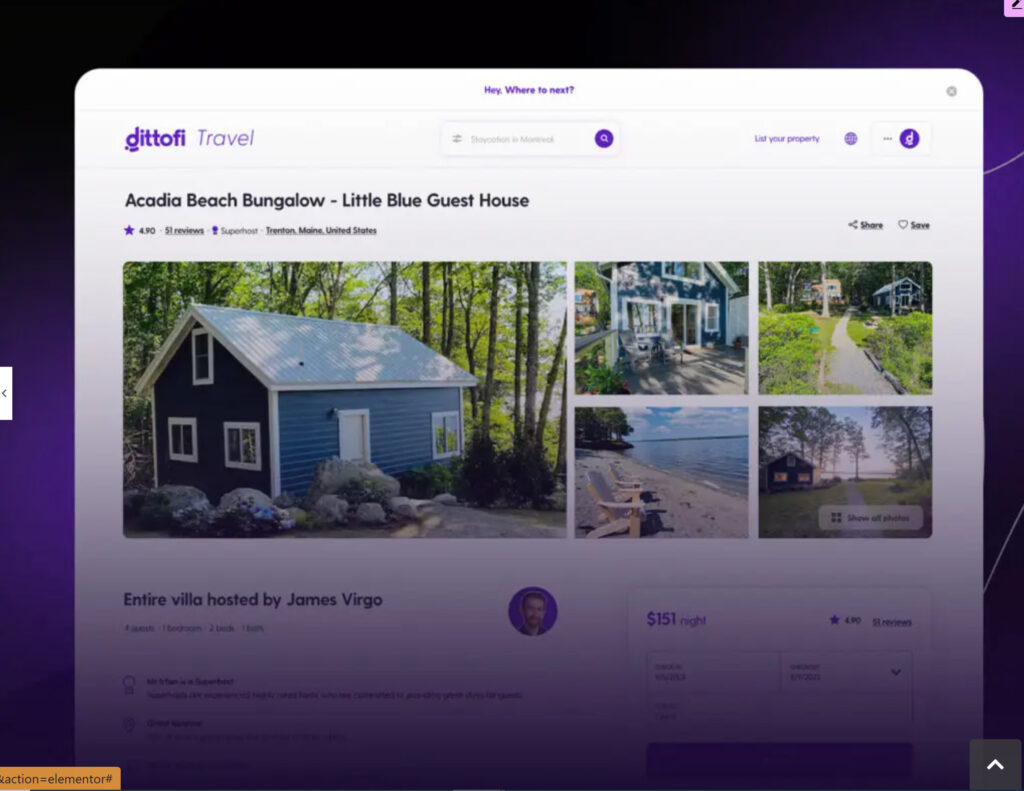
Sellers listing pages are important because, the more professional they look, the more trust buyers will have to purchase the product or service on offer. To help ensure that listing pages are high quality, some marketplaces charge a small listing fee for each listing that the seller creates. This helps ensure that the seller puts maximum effort into each listing however, it can also create some friction with onboarding new sellers.
Website navigation
It is important that your marketplace users can quickly & easily find what they are looking for on your platform. Typically customers will either search directly for a particular item or search by category or location. This means that your marketplace can have either two or three types of search functionality.
- Keyword search is a free text field that allows users to search through all of the listings on the site. Keyword search works very well for all kinds of marketplaces & is an essential feature.
- Category search is for users who wish to search according to a set of predefined categories. You will need to define what these categories are going to be. Most sites have a hierarchical structure with categories & subcategories.
- Location search is a special type of search that is needed for peer to peer marketplaces where users need to travel to a specific location in order to access the asset that they are looking to rent or purchase. For instance, Airbnb & Turo have a powerful location based search feature. This is not easy to develop, however platforms like Dittofi have pre-built, enterprise grade location based search features that you can use.
Online payments
Peer-to-peer marketplaces need to make money so that they can sustain and grow their operations. There are several business models that can be used in order for a marketplace to make money. Each of these requires a way of taking payments online. For instance, the marketplace may accept one off payments, subscription payments, commission payments & so on.
The most common way for marketplaces to take online payments is as an intermediary that sits between the buyer & the seller. In this case, the marketplace will offer a way for the buyer to make a payment for a product or service. The marketplace will then hold the buyers cash in escrow while the seller provides the buyer with the product or service. Once the transaction is complete, the marketplace will release the buyer’s cash to the seller.
There is a lot of regulation that your marketplace must comply with when taking online payments. Legislation can differ from country to country or even state to state. Marketplace app builders like Dittofi can help here by providing you with pre-built payment processing mechanisms. This will help you when initially building online payments into your marketplace. It will also save you the hassle of maintaining & updating your payment processing system to comply with regulatory changes.
Two-sided reviews
Two-sided reviews are important for a marketplace because they create trust and transparency among both buyers and sellers. Reviews also enable users to share their experiences & provide feedback, helping others make informed decisions and choose reputable partners for transactions. This helps encourage participants to uphold high standards & enhances the marketplace’s reputation.
There are various challenges when trying to keep two-sided reviews meaningful. For instance, buyers may threaten to leave a bad review unless they get a discount. There are various strategies to help deal with this kind of behavior such as double blind reviews & a dispute resolution process for unfair reviews.
Communication tools
Communication tools are crucial for two-sided marketplaces as they enable users to negotiate, ask questions, clarify details, & build trust before committing to a transaction. This can encourage marketplace participants to transact more frequently & confidently. For communication that takes place on the platform the marketplace keeps track of interactions between customers so that the marketplace can quickly resolve disputes that arise. For this reason, most marketplaces will have a disclaimer advising that buyers & sellers always stick to written communication within the platform.
Admin features
Behind every successful marketplace is an operations team that manages the daily marketplace operations. This involves helping new buyers & sellers onboard, recover passwords, make, update & cancel bookings, resolve disputes & so on. To make management of daily operations easy, you need a back office or admin system.
How to build and launch a peer to peer marketplace
At Dittofi we’ve helped hundreds of marketplace founders build & launch their own peer to peer marketplaces & other apps.
We’ve seen that entrepreneurs who are most successful build version 1 of their marketplace quickly, launch version 1 early, get real user feedback after launch & then incorporate user feedback into their product.
This methodology of building marketplaces is known as the build, measure, learn loop. A diagram of this is shown below.
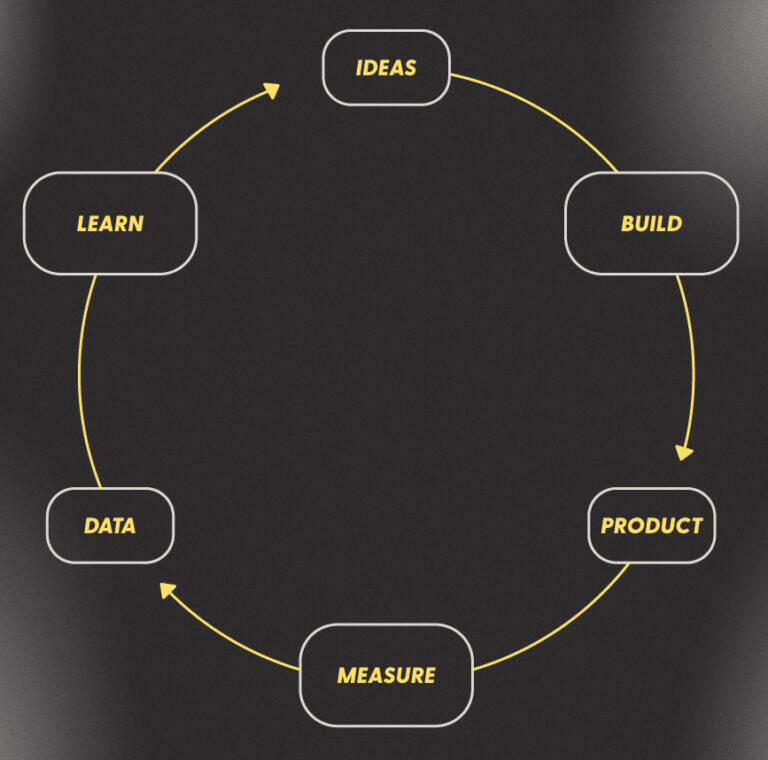
In this section, we will take a look at the process that we’ve used at Dittofi to help founders think through what it is that they are going to build, test out new ideas, acquire users & incorporate user feedback into their products.
Validate your idea
Great businesses solve real world problems for a target audience. For instance, the product marketplace Etsy solves the problem for sellers of “where do I sell my handmade products”. For buyers Etsy solves the problem of “where can I find unique, handmade products”.
However, it can be very difficult to know if the problem you’ve identified really impacts your target audience in the way that you think it does. To help work this out, you need to first of all validate you marketplace idea. Validating your marketplace idea involves testing the market to know if the problem that you’ve identified is a real problem for your target audience. Note that unlike other websites or apps, when building a two-sided marketplace, you need to test the assumptions that you’ve made about both the buy side & the sell side of the marketplace.
To do test your assumptions you then need to design a little product experiments. Each experiment should have a method & a minimum success criteria. In our article Dittofi’s Idea Validation Board, we give you a tool that explains how you can structure low cost product experiments so as to test your assumptions.
An example of a company that did this very well was Airbnb. Airbnb began by identifying a problem for homeowners who wanted to rent out unused space in their homes. They thought that people would book & stay in strangers homes rather than stay at hotels. To test this, they created a basic landing page & invited people to stay at their own home. This allowed them to make some money by renting out their apartment, but it also allowed them to validate that strangers would actually book to stay at each other’s homes.
When validating your idea, make sure that you start to speak with real potential users of your product. This will allow you to also start building a network of prospective users who may well end up being early test users of your product.
Failing to validate your idea is one of the most common mistakes that entrepreneurs make when building a new marketplace. It is very easy to get excited & to start building before validating that you’re solving real world problems. If your idea fails, it will fail fast & without incurring a huge expense. This will allow you to quickly pivot your idea so that you haven’t wasted months of time or tens of thousands of dollars developing a complex website or app that no one actually wants.
Once you’ve validated your idea & found some initial traction, the next step is to choose a business model for your marketplace.
Choose your business model
When building a two-sided marketplace you will need to choose a marketplace business model. The most common business models for a peer to peer marketplaces is the commission model. This will be the model that 99% of marketplaces adopt however there are challenges when it comes to implementing a commission based model.
When you first launch your marketplace, it might be be a good idea to keep the cost of using the marketplace really low or even to offer the marketplace entirely for free. By keeping the cost low, this this will reduce friction when onboarding new users. You could also offer the marketplace free for the first few transactions & then test if people continue to transact as you start to increase the price of the transaction.
Once you’ve chosen your business model, it’s time to build & launch your minimum viable product (MVP)
Build your MVP
Your p2p marketplace minimum viable product (MVP) is the earliest version of your product that you’re willing to share with customers. It is important to launch your MVP fast & at a low cost however, do not rush your development. The MVP should be functional & should have the features that are required for your marketplace to do what you promise to your users it will do.
There are a lot of different approaches to building an MVP. You can design & code the marketplace from scratch, use a dedicated marketplace technology, work with a no-code app builder to fast track the development or use a modern hybrid no-code app builder with dedicated marketplace templates & pre-built components such as Dittofi.
The benefit to using a no-code platform is that you will be able to build your marketplace faster traditional coding. However, no-code platforms are difficult to learn & do not scale well. They also do not allow you ownership over your marketplace source code which means that you’re trapped on their platform.
In contrast, hybrid no-code tools such as Dittofi allow you to build 100% custom, scalable marketplace software, on a modern tech stack in an entirely visual way. Dittofi then automatically translates visual designs into enterprise grade code (React & Google Go) that you can access, modify & own. This gives you all of the speed of no-code app development without any of the drawbacks.
Build with Dittofi's marketplace templates & components
If you’re looking to build your marketplace fast, on a modern & quality tech stack, then Dittofi’s marketplace templates & components might be a great option for you. With these solutions you can setup peer to peer product, service & rental marketplaces in a matter of minutes & immediately have all of the key features that you need for your marketplace. Furthermore, each feature has been fully tested, is developed according to best practices so that it is ready to scale efficiently & is entirely customizable from within Dittofi’s visual editor.
Furthermore, Dittofi’s visual editor enables you to deploy your app onto an enterprise grade hosting model that is cost effective to run & that Dittofi maintains to ensure that it is fully secure.
Using Dittofi, you are able to build & launch your marketplace in less than a day. All without writing any code but also without sacrificing on quality or code ownership.
Launch, learn, iterate and grow
Once your MVP has been completed it is time to launch your marketplace.
Launching a marketplace is hard. You need both buyers & sellers in order to make it work. This is known as the chicken and egg problem. Therefore think through carefully how you plan on onboarding the first set of users. Normally speaking it’s best to start by getting the hardest side of the marketplace first.
Let’s say you start by building out the supply (sellers) side of the marketplace. You can do this by reaching out to a small selection of possible sellers & convincing them to come onto your marketplace. Help them onboard & create their listings. Make sure that you set realistic expectations for them in terms of when they should start to see benefits from signing up to your marketplace.
After you have sellers listed on your marketplace, go out & find the buyers. You can do this by advertising the services that are listed for the sellers. Many of Dittofi’s clients will use Google Ads to do this initially while building a longer term & more sustainable content marketing strategy. That being said, there are various ways that you can market your sellers services, for example influencer marketing, posting in Facebook groups, other paid for channels. If you don’t know how to market the sellers products or services, then get the help from someone who does.
During the early stages it is fine to do things that don’t scale. Your initial users are going to be the lifeblood of your platform. Organize regular touchpoints with both your buyers & sellers & make work hard to make them happy. Not everyone will be happy & some users may be unreasonable. As Paul Graham, the legendary founder of the Y-Combinator says, you need to learn how to identify & avoid toxic clients who eat up your time & are only there to take advantage of you. Therefore, focus on delivering a great product & making your clients happy & don’t waste time on users who will never be happy or are looking for a handout.
Post launch, identify some marketplace metrics that you can use to measure the success of your marketplace. You should choose metrics that will give you real insight into how your marketplace is performing & you need to track these metrics & to also take the time to review them periodically.
As you grow, look for ways to optimize your marketplace & continually iterate on the quality of service provided. This will involve building out operations, marketing, sales & so on. Finding good quality people to hire & collaborate with to support you in your growth is essential. Furthermore, you should continually be exploring different growth avenues, looking for the lowest cost / least effort way to find new marketplace users.
Notice, If you’ve built your marketplace using Dittofi, your technology will be in a good place to scale up at this point. This is because Dittofi makes use of quality code generation technology to ensure that your marketplace is able to run efficiently & scale up on demand.
Peer to Peer Marketplace Software & Templates
Dittofi has three peer to peer marketplace templates that you can use, customize & launch.
Dittofi Peer to Peer Marketplace Templates
Peer to peer product marketplace
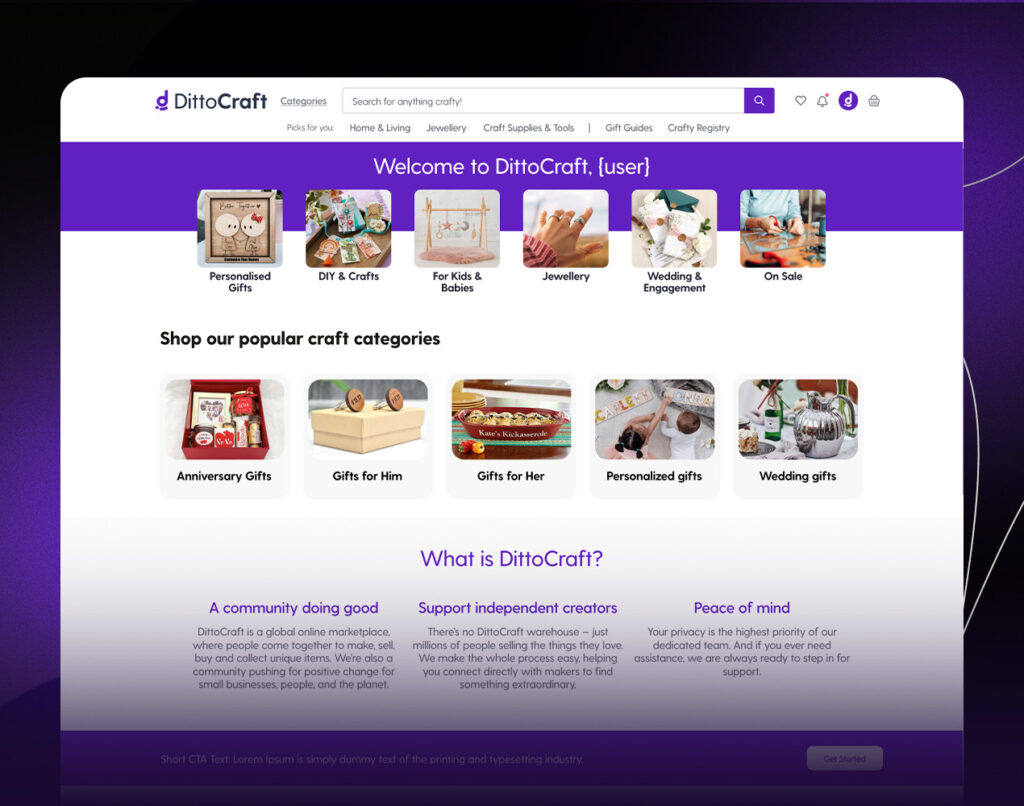
Use Dittofi’s Peer to Peer Products Marketplace Template to build a website like Etsy, Ebay, Amazon or any other peer to peer product marketplace website.
Key features include:
- Product listings
- Product details pages
- Two-sided reviews
- Payments
- & much much more.
Peer to peer rental marketplace

Use Dittofi’s Peer to Peer Rentals Marketplace Template to build a website like Airbnb, Vrbo, Turo or any other rental marketplace website.
Key features include:
- Location based search
- Holding funds & delaying payouts
- Two-sided reviews
- Availability & booking management
- & much much more.
Peer to peer service marketplace

Use Dittofi’s Peer to Peer Service Marketplace Template to build a website like Fiverr, Upwork, Thumbtack or any other service based marketplace.
Key features include:
- User profiles
- Online payments
- Holding funds & delaying payouts
- Listings
- Reviews
- & much much more.
Become a Marketplace Insider
Join our inner circle for exclusive insights, coveted trade secrets, and unparalleled strategies – your journey to marketplace dominance begins here.
Final Thoughts: Launch Your Peer to Peer Website Today
Now that you know what a peer to peer marketplace is & how best to build one, the next step to really understanding how these platforms work is to build your own. There are many reasons why you might want to build a peer to peer marketplace. For example, you might want to make some extra cash, experiment with building a business or simply to learn what it takes to build a two-sided peer to peer marketplace.
Dittofi is the fastest way to build an enterprise grade peer to peer marketplace. The platform (online marketplace builder) enables you to do this without writing any code. However, we stick to programming best practices & translate all of the visual designs into quality, modern code (React & Google Go) that you can access, edit, export, deploy & own.
If you’d like to consult with us about how to build your peer to peer marketplace, schedule a call with one of our app consultants or, sign up to Dittofi now & build your marketplace today.

